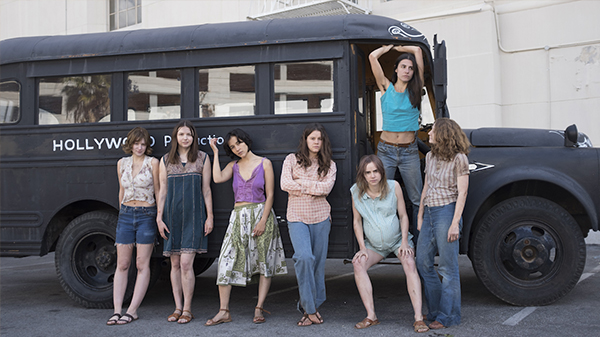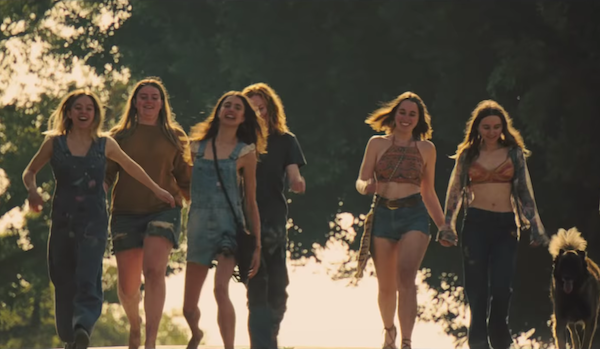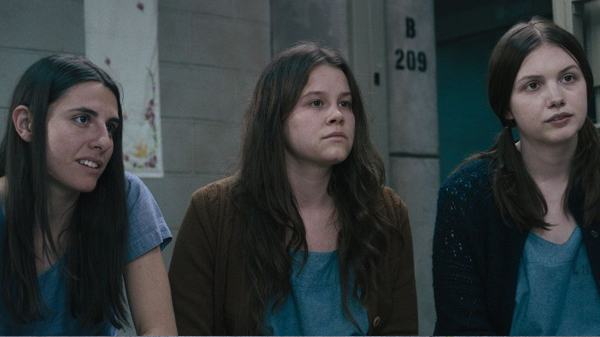While Quentin Tarantino’s ninth film doesn’t glorify or dignify Charles Manson in the way early speculation feared, his vision of late 1960s America offers a very different depiction of the women of the Manson Family to that of Mary Harron in her film Charlie Says. Mary Beth McAndrews teases out the key disparities in the storytelling methods constricting these women.
“There is nothing about what we did to those people that's all right, and if I can tell these kids anything, it's that Charles Manson is not someone to follow… When I wake up every morning, I know that I am a destroyer of the most precious thing, which is life. And living with that is the most difficult thing of all. But I do it because it's what I deserve, to wake up every morning and know that.”
-Patricia Krenwinkel
In the midst of the world’s obsession with true crime, two films have been released in 2019 that tackle Charles Manson and the infamous Manson Family murders. One is Quentin Tarantino’s Once Upon A Time… In Hollywood, a film that looks back at the golden age of Hollywood through the eyes of a washed up actor, played by Leonardo DiCaprio, and his stunt double, played by Brad Pitt. Tarantino’s fantasy involves revisiting and revising the murder of up-and-coming star Sharon Tate (Margot Robbie) at the hands of the Manson Family. Instead of showing the Mansons murdering Tate, Tarantino’s version of events sees DiCaprio and Pitt kill the three young adults in increasingly violent ways, rewriting a horrific narrative and envisioning a new future. The other film, Charlie Says, is directed by Mary Harron and follows a different route, telling the true story of three Manson women—Leslie Van Houten, Patricia Krenwinkel, and Susan Atkins— through their own eyes. While both films serve a different purpose, they are united in their focus on the Manson girls, their acts of violence, and the dangers of male fantasy.
The Manson Family was led by Charles Manson, a wannabe rockstar who started a commune near Los Angeles in the late 1960s. Manson collected young women (and a few men) that he could easily manipulate with speeches about free love, letting go of your ego and living in the now. The women he targeted were often runaways, searching for a new life outside of their controlling families or school bullies, as was the case for Van Houten and Krenwinkel. But, while he at first preached an ego-less existence, his sermons shifted to predictions of Helter Skelter, (his name for the apocalypse) and the impending race wars between white and black people. To trigger Helter Skelter, Manson and his group prepared an album that he wanted to be produced by Terry Melcher. But, Melcher never arrived to hear the album. So Manson took the apocalypse into his own hands. Manson instructed Krenwinkel and Atkins, along with male follower Tex Watson, to go to Melcher’s home and murder whoever was there. Unfortunately for Sharon Tate, she and husband Roman Polanski were now renting the place. There, the Manson followers found the heavily pregnant Tate, along with four of her friends. Each was stabbed multiple times, and Atkins scribed “PIG” on the wall in Tate’s blood. They ended the lives of five young people on the night of August 8, 1969 and committed several more murders within the next 48 hours. Van Houten, absent from the night of Tate’s death, was involved in the subsequent killings.
When putting this harrowing story to the screen, Harron focuses solely on the Manson girls to provide detailed context to their lives, while Tarantino uses them sparingly, as part of a larger narrative about white male heroes. The films serve different purposes — Charlie Says depicts history, Once Upon a Time… In Hollywood creates fantasy — but what they share is how each addresses the ways in which male desire is projected onto the female body through sex and violence. Tarantino constructs an idealised vision of 1960s Hollywood, one where a washed up actor can find success, where a homicidal stunt double can become a hero, and where Sharon Tate can survive. But to achieve this fantasy, women must still be brutally murdered. Only through the deaths of the Manson women can Booth the stunt double redeem himself and inadvertently save Tate, her baby, and her friends. While Tate evades a horrific death, other women are still murdered in this tale; there is no avoiding the brutalisation of the female body. What makes this type of violence right, in Tarantino’s universe, is that these were the women who deserve to be killed. It is not about saving women from violence, but determining which ones deserve it.
In contrast, Harron aims to give the Manson girls a voice by putting Van Houten, Krenwinkel, and Atkins front and centre from the beginning. As they sit in prison, they are the ones describing their experiences with Manson, from beautiful nights sitting by the fire and getting high together, to the moments when Manson began hitting them. With each flashback, the process of their brainwashing becomes clearer. Sex and threats of violence were used to both please and scare, as Manson opened them up to a world of pleasure, but then then countered this with pain. The women are allowed to tell their story and be seen as more than just sexy or monstrous; Harron shows these three women as just wanting to be loved and seemingly doing anything to get there.
It would seem that Tarantino views the acts of the Manson Family with extreme hatred – of course, these murders do not deserve to be pardoned or excused. However, in framing his hatred, he creates a dichotomy between the sexualised girl and morally vile female with the Manson girls; they are either eager sex machines with an open mouth, or vile beings who deserve punishment for their transgressions, which, in Tarantino’s case, is murder. For the majority of the film, the Manson girls are portrayed as waifish young women with long hair, crochet crop tops, and bare feet. They prance around Los Angeles, hitchhiking and flirting with drivers, including Brad Pitt’s Cliff Booth. Booth’s interaction with one Pussycat (played by Margaret Qualley) reinforces such sexualised expectations, as she openly offers blowjobs during their drive to the Manson ranch. She, and the other women, use their sexuality to manipulate, rather than addressing how they themselves are manipulated.
The sexual and violent natures of the Manson girls converge as Booth meets Squeaky (Dakota Fanning). Booth confronts her, asking to see George Spahn, owner of the ranch. With her low, angry voice and greasy hair, Squeaky guards her lair—a shack full of dirty dishes, mouse traps, and congealing food— refusing to let Booth in, claiming George was napping after “fucking his brains out” that morning. In this moment, the Manson girls are exposed as sinister, hiding old men away and having sex with them so they can use the ranch for themselves. As Booth, and by extension the audience, realises this, the girls begin shrieking for him to leave. Between the greasy Squeaky and the screaming women, this is no longer an idyllic utopia of women. Their sex appeal has melted away and exposed the scheming monsters within. The Manson family doesn’t reappear until the end of the film, and they look very different when they return. The bohemian outfits are swapped for black trousers and turtlenecks. Their previously bare bodies are now hidden and they are transformed into villains, clutching their weapons and ready to kill. The Manson girls exist in a binary of sex and evil that serves to depict a skindeep narrative, serving Tarantino’s fantasical world where Sharon Tate lives and her murderers are brought to bloody justice.
Harron’s depiction of the girls has the young women occupy a nebulous space between good and bad. There, they are able to tell stories about their experiences with Manson not with the aim of redemption, but to better understand the circumstances that lead to the violent events. Importantly, each girl is depicted as just that: a naive young woman lured into the commune and shaped into what Manson wanted her to be. Manson’s effects on each girl also surface during their interactions with their social worker Karlene as they explain his ideas of letting go of the ego and how he would protect them from Helter Skelter. As they continue sharing their stories, however, each woman begins to slowly realise the gravity of their actions and the true meaning behind Manson’s words. In focusing on Leslie, Patricia, and Susan’s stories, rather than having them as side characters or mere props, Harron creates a better understanding of the infamous trio. They are real young women who jumped at the chance of experiencing what they thought was love.
There are two sides to every story, so we’re told. Tarantino places villainy directly on these women’s shoulders, portraying them as a group of succubus who prowl the Hollywood Hills for blood. Harron also depicts them as villains, but with the understanding that they were vulnerable girls under a LSD-infused spell. Both films accept that these women are responsible for heinous crimes, but one creates a new version of history reliant on violent catharsis, while the other makes the audience confront history as it happened on a deeper, more complex level. Women are victims in both films, but to different men. Tarantino’s girls are victims of his own violent imagination, whereas Harron’s are victims of a misogynistic leader who turned to murder when he couldn’t get his way. But does it matter how these women were treated by men either on screen or behind the camera? They did commit heinous crimes, so why do they deserve a redemptive narrative? Yet, it’s not about what these women deserve, but how filmmakers wish to portray them that speaks volumes. To some, the Manson girls are expendable props, easily used and thrown away. To others, they are three young women with a story to tell.
Mary Beth McAndrews (@mbmcandrews) is freelance writer based in Chicago. She loves all things macabre, and mostly writes about the intersection of horror and gender. She is an editor for Much Ado About Cinema and contributor for Nightmare on Film Street.
READ ME is a platform for female-led writing on film commissioned by Girls on Tops. Louisa Maycock (@louisamaycock) is Commissioning Editor and Ella Kemp (@ella_kemp) is Contributing Editor.




